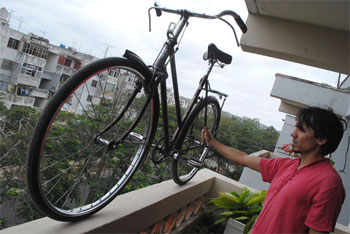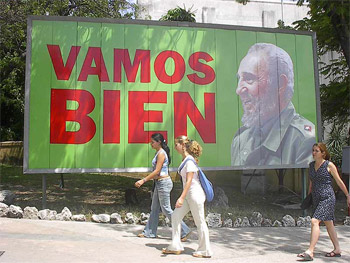Cuba/Bicycles: Safeguarding the Future
Erasmo Calzadilla
 HAVANA TIMES — During the economic crisis of the 1990s, one of the deities of our Olympian society had the brilliant idea to promote the use of bicycles.
HAVANA TIMES — During the economic crisis of the 1990s, one of the deities of our Olympian society had the brilliant idea to promote the use of bicycles.
Bought from China, they imported huge quantities of these rough-hewn and archaic devices, which were well suited to our crumbling streets and the robust Cuban bodies. They also acquired bike factories, outfitted repair shops, designated bicycle lanes and purchased spare parts.
Thanks to these measures, bicycles became instrumental in the life and culture of Cuba. They became associated not only with practical questions and getting to work, but also with recreation, love and death.
In Havana, there even appeared bici-tiradores (literally “bike-shooters,” men who would masturbate publicly while on bicycles so they could escape possible pursuers).
But when the first oil-filled Venezuelan super-freighter poked its nose into our territorial waters, the country’s top leadership forgot about bikes. For them, it had been like a fleeting childhood pastime – with us ultimately suffering the consequences.
Never again did we see Chinese bikes distributed at workplaces, and the cost of spare parts went through the roof. My father’s bike sat mothballed in the corner of a back room.

It was a time of relative abundance, of hope, with Fidel announcing on huge billboards “VAMOS BIEN” (“we’re doing fine”). It seemed to be the end of the public transportation crisis, one of our endemic plagues – but it resurrected itself.
Now the crisis is international and, from all indications, it’s digging in and spreading.
That’s why the first guy who passed by me selling one of those used Chinese clunkers, I dug down deep in my pocket.
I’m not going to dwell on the ordeals I’ve gone through since then when trying to exchange parts for my bike. I’ve been shamelessly ripped off both by private and state-run stores.
They’ve done everything from jack up the prices to sell rotten inner-tubes and tires, as well as uneven connecting rods, bent axles and many other flawed items (all sold in state-run stores that don’t recognize defects).
After a long list of such incidents, I’ve racked up plenty of experience, so it’s not so easy to cheat me anymore. But learning has almost cost me another bike.
Fortunately, my old Chinese bike still rolls through the streets. With its help I’m able to take care of business, take my girlfriend for rides, keep my paunch at bay and even pick up a little change.
And if things get worse, I’ll get on the crest of the wave by pedaling.

Dear Erasmo,
Have you ever wondered how much would cost to build a subway system in Havana?
Even when overcrowded and you feel like you’re inside a sardine’s can, I cannot imagine a better urban transportation method:
http://rede.outraspalavras.net/pontodecultura/files/2012/07/120717-Metr%C3%B4SP2.jpg
While it is not common in Havana for women to ride bicycles as their primary means of transportation, it is still very common in ‘el campo’ or that is too say most areas outside of the larger towns. I brought a trail bike from the US to Cuba several years ago and it costs me more than $500 in airline fees alone. I agree with Erasmo regarding the price of bike parts. A simple set of brake pads costs three times as much in Havana as they do at WalMart near my house here in the US.